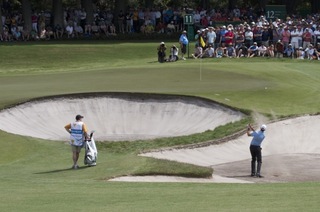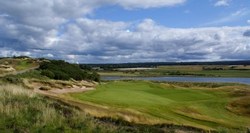Q&A With Gil Hanse
/The 2012 Aberdeen Asset Management Scottish Open returns to Castle Stuart minus sponsor Barclays and hopefully minus freak thunderstorms that turned the crispy links into a mess that included a bizarre mudslide. Though the Gil Hanse-Mark Parsinen course will be much greener thanks to the UK's non-stop rains, Mother Nature will hopefully allow the Inverness, Scotland layout to be at its best.
The return provides an opportunity to make Hanse answer a few questions about the course and get a Rio Olympic course update (and full disclosure: I've worked on a number of design projects with Gil and hope to again in the future).
GS: Since being selected for the Rio 2016 Olympic commission, you've been back to Rio to walk the site and make modifications. How did that go and did it yield any significant deviations from your original plan?
GH: The site visits have gone very well. We are excited about the land, and the more time we get to spend on it, the more interesting the natural features we are finding appear to be. We shifted a few greens and tees around to take advantage of some natural features that we found, and also to reduce the amount of water that was green side on several of the opening holes. However, the routing stays much the same and the holes are roughly in the same configuration, the natural terrain for the "upper" holes is better than first imagined and those holes should be shaped right out of the existing landscape.
 GS: You will be visiting Australia soon for the first time for inspiration in the Rio design. What are you looking to learn there and why did seeing Sandbelt golf become a priority?
GS: You will be visiting Australia soon for the first time for inspiration in the Rio design. What are you looking to learn there and why did seeing Sandbelt golf become a priority?
GH: We have been very fortunate to have seen so many of the great courses in the world and to study their designs. However, neither Jim or I have been to Australia to study the great sandbelt courses. Having seen photos, and talked to people such as yourself about these courses, it seemed that we could draw a parallel to our site in Rio from a vegetation, sand, and topographical context to these courses. As a result, we feel it is imperative for us to travel down there and spend time on these great courses. Our good friends at Clayton/Ogilvy design have agreed to be our tour guides, so I am certain we will see some great architecture on the visit. We are hopeful that the configuration of their green complexes and the bunkering of the courses will be a fit for Rio, as will the reliance on short grass surrounds for the green complexes.
 GS: Castle Stuart hosts the Scottish Open for the second time, how big of an influence do you think it's success had on getting the Olympic commission?
GS: Castle Stuart hosts the Scottish Open for the second time, how big of an influence do you think it's success had on getting the Olympic commission?
GH: I believe that it had a significant influence on our selection for the Rio course. The selection committee made it clear that they were looking for a resume that included courses that have hosted significant tournaments. All of our other tournament course experience has been of a restorative or renovated nature, so to have an original design also be part of that submission was critical. The fact that the course was well received by the players, prior to the storm events, I believe had an impact on our selection.
GS: Last year's freak weather made it hard to fully judge the course, though players widely praised it and the use of a links style design prior to the Open. Yet there were many modifications made, can you enlighten us on those and whether you were consulted?
GH: Not sure if the modifications were in the "many" category but we did add some items to the course. As our co-designer on the course, Mark Parsinen, who is also the owner, was primarily in charge of coordinating these changes with the European Tour, based on their analysis and feedback.
 The primary feedback was that a couple of holes could use some tightening of the landing areas, so bunkers were added on the 5th and 14th holes, and several holes were lengthened. Interestingly enough, many of these additional tees were already constructed during the original design of the course. We built landforms for them, but grassed them in rough grasses, but we knew that we might need to add some flexibility to the length of the course if we were given the opportunity to host a championship. These new tees will be used if the wind conditions are appropriate for their use. We were consulted by Mark on these changes, and I think that they will have a minor influence on the outcome, we are just hoping for some good weather this year!
The primary feedback was that a couple of holes could use some tightening of the landing areas, so bunkers were added on the 5th and 14th holes, and several holes were lengthened. Interestingly enough, many of these additional tees were already constructed during the original design of the course. We built landforms for them, but grassed them in rough grasses, but we knew that we might need to add some flexibility to the length of the course if we were given the opportunity to host a championship. These new tees will be used if the wind conditions are appropriate for their use. We were consulted by Mark on these changes, and I think that they will have a minor influence on the outcome, we are just hoping for some good weather this year!
GS: As part of your studies as well as your time on site at Castle Stuart, you've spent a great deal of time in the UK and in particular in Northern Scotland. If someone were to plan a trip to see Castle Stuart and perhaps the new Trump course, could you give us a few lesser known links that are worth playing?
GH: Some of my favorites include Cruden Bay, Lossiemouth, Brora, and Fortrose and Rosemarkie, and Boat of Garten is a fun inland course. Of course any trip to this part of Scotland should include stops at Royal Aberdeen and Royal Dornoch, which is a masterpiece in my opinion.











